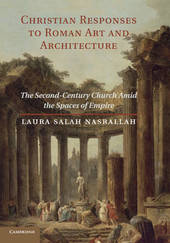
|
Christian Responses to Roman Art and Architecture: The Second-Century Church amid the Spaces of Empire
Paperback / softback
Main Details
| Title |
Christian Responses to Roman Art and Architecture: The Second-Century Church amid the Spaces of Empire
|
| Authors and Contributors |
By (author) Laura Salah Nasrallah
|
| Physical Properties |
| Format:Paperback / softback | | Pages:352 | | Dimensions(mm): Height 254,Width 178 |
|
| Category/Genre | Ancient and classical art BCE to c 500 CE
Church history |
|---|
| ISBN/Barcode |
9781107644991
|
| Classifications | Dewey:270.1 |
|---|
| Audience | | Professional & Vocational | | Tertiary Education (US: College) | |
|---|
| Illustrations |
1 Maps; 31 Halftones, unspecified
|
|
Publishing Details |
| Publisher |
Cambridge University Press
|
| Imprint |
Cambridge University Press
|
| Publication Date |
15 August 2011 |
| Publication Country |
United Kingdom
|
Description
Laura Nasrallah argues that early Christian literature addressed to Greeks and Romans is best understood when read in tandem with the archaeological remains of Roman antiquity. She examines second-century Christianity by looking at the world in which Christians 'lived and moved and had their being'. Early Christians were not divorced from the materiality of the world, nor did they always remain distant from the Greek culture of the time or the rhetoric of Roman power. Nasrallah shows how early Christians took up themes of justice, piety and even the question of whether humans could be gods. They did so in the midst of sculptures that conveyed visually that humans could be gods, monumental architecture that made claims about the justice and piety of the Roman imperial family, and ideas of geography that placed Greek or Roman ethnicity at the center of the known world.
Author Biography
Laura Salah Nasrallah is Associate Professor of New Testament and Early Christianity at Harvard Divinity School. She is the author of An Ecstasy of Folly: Prophecy and Authority in Early Christianity and co-editor of Prejudice and Christian Beginnings: Investigating Race, Gender, and Ethnicity in Early Christian Studies and From Roman to Early Christian Thessalonike: Studies in Religion and Archaeology.
ReviewsReviews of the hardback: '... provocative, convincing ... reads second-century Christian literature, texts of the Second Sophistic, and the remains of material culture as a broad corpus concerned with the production and contestation of ethnicity, geography, and empire in the high Roman Empire ... skilfully couples images, maps, and archaeological reconstructions with lucid written discussions of art and archaeology. Nasrallah's approach challenges received historical narratives that consider Christian literature sui generis ... [she] demonstrates that early Christian apologetics emerged from the same political and social milieu as other second-century Greek literature ... [she] re-reads 'canonical' second-century texts in terms of spatial and geographic agonism. Although focused in particular on Christian apologetics, Nasrallah shows classicists and ancient historians that any cultural history of second-century culture that ignores early Christian texts is incomplete. A must read for scholars and students of early Christianity, classics, and ancient history ... Essential.' J. Schott, Choice '... we should end our review of Nasrallah's work with a real sense of gratitude for a work of intriguingly suggestive and thoughtful scholarship.' Journal of Ecclesiastical History '... the book is ambitious in its methodology and reach, but Nasrallah has offered a cogent and well-organised thesis that is well worth reading. This art historian learned some new ways of viewing well-known works of art, which made this a rewarding read.' Journal of Church History 'This excellent book is a delight to read, and should garner the avid attention of anyone interested in early Christianity and its engagement with Roman culture, or in the spatial and material readings of ancient texts more generally. It is hard to do justice to the outstanding quality of the work ... or the insights that dot every page. The mastery of the secondary literature both for the ancient texts and for the archaeological examples is enviable in its breadth and depth, as well as its theoretical sophistication. Also deserving of note (and emulation!) is Nasrallah's generous and engaged treatment of her colleagues' work, and her lively, fluid style ... an unqualified success at its goal, to 'stimulate the reader's imagination to question the prescriptive rhetoric of elite sources, to think spatially, and to look to archaeological materials as well as literary'.' Journal of the American Academy of Religion
|